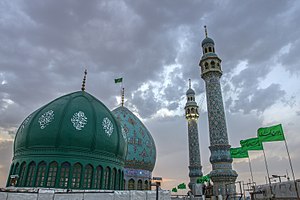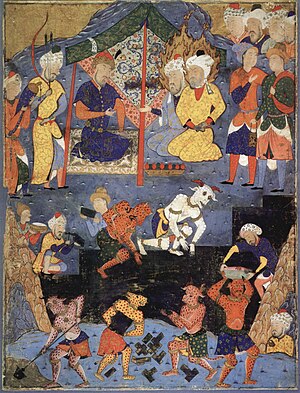Mahdism

Mahdism(Persian:مَهدَویّت,[1]Arabic:المهدوية) in theTwelverbranch ofShia Islam,derived from the belief in the reappearance of the Twelfth ShiiteImam,Muhammad al-Mahdi,as thesaviorof theapocalypsefor the salvation of human beings and the establishment of peace and justice. Mahdism is a kind ofmessianism.From this perspective, it is believed thatJesus ChristandKhidrare still alive and will emerge withMuhammad al-Mahdiin order to fulfil their mission of bringing peace and justice to the world.[2][3][4]
Mahdism in Quran
[edit]Many verses of theQuranare related to Mahdism,[5][6]such as verse 105 ofAl-AnbiyaSurah:
«وَ لَقَدْ کَتَبْنَا فیِ الزَّبُورِ مِن بَعْدِ الذِّکْرِ أَنَّ الْأَرْضَ یَرِثُهَا عِبَادِیَ الصَّالِحُون»
"Certainly We wrote in the Psalms, after the Torah: ‘Indeed My righteous servants shall inherit the earth’."
The commentators have considered the fulfillment of the promise mentioned in the verse at the time of thereappearanceofImam Muhammad al-Mahdi.[7][8]Also, verse 5 ofAl-QasasSurah:
«وَ نُرِیدُ أَن نَّمُنَّ عَلیَ الَّذِینَ اسْتُضْعِفُواْ فیِ الْأَرْضِ وَ نجَعَلَهُمْ أَئمَّةً وَ نجَعَلَهُمُ الْوَارِثِین»
"And We desired to show favour to those who were abased in the land, and to make them imams, and to make them the heirs"
Some have considered the interpretations of this verse to be related toMuhammad al-Mahdi[9][10]and others have considered it to be related to the return (Rajʽa) of theImamsand the return of the government to them.[11][12][13]Verse 55 of SurahAn-Nur:
«وَعَدَ اللَّهُ الَّذِینَ ءَامَنُواْ مِنکمُ وَ عَمِلُواْ الصَّلِحَتِ لَیَسْتَخْلِفَنَّهُمْ فیِ الْأَرْضِ کَمَا اسْتَخْلَفَ الَّذِینَ مِن قَبْلِهِمْ وَ لَیُمَکِّنَنَّ لهُمْ دِینهَمُ الَّذِی ارْتَضیَ لهَمْ وَ لَیُبَدِّلَنهُّم مِّن بَعْدِ خَوْفِهِمْ أَمْنًا یَعْبُدُونَنیِ لَا یُشْرِکُونَ بیِ شَیْا وَ مَن کَفَرَ بَعْدَ ذَالِکَ فَأُوْلَئکَ هُمُ الْفَاسِقُون»
"Allah has promised those of you who have faith and do righteous deeds that He will surely make them successors in the earth, just as He made those who were before them successors, and He will surely establish for them their religion which He has approved for them, and that He will surely change their state to security after their fear, while they worship Me, not ascribing any partners to Me. Whoever is ungrateful after that—it is they who are the transgressors"
Also it is known to be related to Mahdism issues. Some have considered the fulfillment of the promise mentioned in the verse at the time of the reappearance of theTwelfth Imam, Muhammad al-Mahdi[14]and some have considered the community mentioned in the verse to be achievable only at the time of the reappearance of Muhammad al-Mahdi.[15]

Mahdism in Twelver branch
[edit]TheShiitesof theTwelverbranch ofShia Islambelieve that according to the divine promise, a descendant ofMuhammad, Prophet of Islamor his namesake, the ninth child of the descendants ofHusayn ibn Ali,willappearwith the epithet of "Mahdi"[18]and will spread justice throughout the earth.[19]
According to this belief,Mahdi,the son ofHasan al-Askari(the eleventh Shiite Imam), was born in 870 CE. Upon the death of his father, while he was still a child, after the early years of hisImamate,he disappeared and would only contact his followers through hisfour successive deputies.[20][21]The period of the so-calledminor occultationor first occultation, in which Mahdi was not in direct contact with the people, only through his special deputies,[22]which was mostly in contact with the Shiites. According to official tradition, in 940 CE, the fourth and last delegate received a final letter signed by the hidden Imam in which he declared that henceforth and "until the end of time," no one will see him or be his representative, and that whosoever declares otherwise is no less than an imposter. Thus a long absence began, the so-calledmajor occultationor second occultation.[21]
Some late Shiite scholars who have questioned or rejecting Mahdism includeAbolfazl Borqei Qomi,[23][24]Heidar Ali Qalmadaran Qomi, andMohammad Hassan Shariat Sanglaji.[25]
Among the present scholars who have worked on Mahdism isLotfollah Safi Golpaygani.He has two important works in this field,Selected Trace About the Twelfth Imam[26][27]andImamate and Mahdism[28][29]).[30][31]
Mahdism in other Shiite branches
[edit]One of the events that spread the idea of Mahdism was the sudden death ofIsmail,the son ofJa'far al-Sadiq(the sixth Imam of the Shiites), in 762 CE, who, according to theIsma'ilismShiites, had previously been appointed as the seventh Imam of the Shiites. Although most Shiites gathered around Ja'far al-Sadiq's other son,Musa al-Kadhim,a minority of Shiites did not accept Ismail's death, claiming that Ismail was still alive and hiding himself. According to them, Ismail is the absent Imam.[32]With the rise of theFatimid CaliphateinEgypt,the epithet of "Mahdi" was attributed to the first Fatimid caliph and his successors, citing hadiths narrated by theIsma'ilistsand other sources. However, the Isma'ilists expect the seventh Isma'ili Imam to appear under the name ofQa'imat the end of time.[33]
In theZaidi Shi'ismsect, who do not consider the Imams to have superhuman powers, belief in Mahdism is very inconspicuous. Throughout history, many people have beenconsidered as "Mahdi"or claimed to be alive and absent. One of them wasHusayn ibn Qasim Ayani,the leader of a sect branching out fromZaidi Shi'ism,called the Husaynieh sect. A group denied his death and claimed him as "Mahdi" and believed that he wouldreturn.But this beliefs about these people is not recognized by theZaidi Shi'ismmajority.[33]
Mahdism in Sunni branch
[edit]According toReza Aslan,with the development of the Mahdism doctrine among the Shiites,Sunnijurisprudencescholars tried to distance themselves from belief in the Mahdi.[32]According toWilferd Madelung,despite the support of belief in the Mahdi by some important Sunnitraditionists,belief in the Mahdi has never been considered as one of the main beliefs of Sunni jurisprudence. The Mahdi is mentioned in Sunni beliefs, but rarely. Many prominent Sunni scholars, such asAl-Ghazali,have avoided discussing this issue. Of course, according to Madelung, this avoidance was less due to disbelief in the Mahdi[33]and more (according to Reza Aslan) due to wanting to avoid disputes and social riots.[32][33]
There are exceptions such asIbn Khaldunin the book "Muqaddimah"who openly opposes belief in the Mahdi and considers allhadithsrelated to the Mahdi to be fabricated. There are different views among the traditionists and scholars who have dealt with the Mahdism issue. The epithet of "Mahdi" has been mentioned many times in the book "Musnad"byAhmad ibn Hanbal(founder of theHanbalischool of Sunni jurisprudence— one of the four major orthodox legal schools ofSunni Islam,and also one of the four Sunni Imams) and various hadiths about the signs of the reappearance of the "Promised Mehdi" (and Jesus in his cooperation) mentioned there. Ahmad ibn Hanbal has narrated in his work that:
Sufyan ibn ʽUyaynahfromAasim ibn Abi al-Najud,narrated a hadith fromAbdullah ibn Masud[acompanionof the Islamic prophetMuhammad] from the Prophet Muhammad:
«لا تقوم الساعة حتی یلی رجل من اهل بیتی، یواطی ء اسمه اسمی.»
"The resurrection will not take place until a man from my family namesake with me emerges."[34]
In mentioning the importance and validity of Ahmad ibn Hanbal's "Musnad" among the Sunnis, it is enough thatTaqi al-Din al-Subkiwrites on page 201 of the first volume of "Tabaqat al-Shafeiyah":[35]
"Ahmad ibn Hanbal's Musnad is one of the basis of Muslim beliefs"
— Taqi al-Din al-Subki,"Tabaqat al-Shafeiyah",1st volume,p. 201
AlsoAl-Suyuti,a Sunni Egyptian Muslim scholar, has discussed the validity of Ahmad ibn Hanbal among Sunnis in the introduction to the book "Jam al-Javameh".[36]Ali ibn Abd-al-Malik al-Hindi,the author ofKanz al-Ummal,says in that book:
«کل ما فی مسند احمد حنبل فهو مقبول»
"What is in the book" Musnad "of Ahmad ibn Hanbal is accepted by the Sunnis."[37]— "Kanz al-Ummal",1st volume,p. 3
In some hadiths in Sunni books, "Mahdi" is the same as "Jesus Christ", while in other narrations there is no mention of the identity of that person, or it is said that "he rises with Jesus." The Mahdi is also mentioned as one of the descendants ofHusayn ibn Ali,the descendants ofHasan ibn Alior the son ofHasan al-Askari,the twelfth Imam of Shiites.[33]Throughout history to the present day, there have been long debates among Sunni scholars about the "savior" role and the "political" role of the Mahdi.[32]
But according toSeyyed Hossein Nasr,the Sunnis believe that the Mahdi is from the family of Muhammad, the Prophet of Islam and will emerge with Jesus in the end times. He also writes that the belief in the coming of the Mahdi is so strong among Muslims that throughout history, especially in times of pressure and hardship, has led to the emergence of claimants of "Mahdism".[38]Contemporary Sunni writers such asAbd al-Muhsin al-Ibad,Muhammad Ali al-Sabuni,andAbd al-Aziz ibn Bazhave also referred to the hadiths attributed to the Prophet of Islam about the Mahdi and the savior of the end times in their books and speeches, and have considered these hadiths trustworthy because have been mentioned frequently by different narrators.[39][40][41]
According toDenise Spellberg,the concept of "Mahdism", although not one of the main Sunni beliefs, has been considered by Sunnis throughout history. In 1881,Muhammad Ahmadclaimed to be the Mahdi inSudanand startedan uprisingthat was suppressed in 1898 by British forces. Belief in Mahdism spurred uprisings in the west and north ofAfricain the nineteenth century. In 1849, a person namedBo Zianled an uprising inAlgeriaagainst the French tax system and the occupation of his country by the French under the name of Mahdi.[42]
Political Mahdism
[edit]Abdolkarim Soroushis one of the few thinkers who has analyzed the relationship between Mahdism and politics and presented a new perspective on Mahdism. He believes that political Mahdism has historically manifested itself in politics in at least four ways:[43][44][45][46]
- The theory ofGuardianship of the Islamic Jurist:The theory of Guardianship of the Islamic Jurist, which is incompatible withdemocracy,is the child of political Mahdism. Political Mahdism justifies the special privileges ofFaqīhsfor government in the theory of Guardianship of the Islamic Jurist. Political Mahdism, based on the theory of Guardianship of the Islamic Jurist, presupposes the "supremeFaqīh"as the deputy ofMuhammad al-Mahdiand gives the same authority to the "supreme Faqīh" in power and possession of the properties of the Muslims population, that the absent Imam has.
- The theory of monarchy on behalf of the Imam of theSafavidkings: Another form of political Mahdism throughout history thatAbdolkarim Soroushrefers to has been the theory of "monarchy on behalf of the Imam of the Safavid kings." This theory was in fact the political theory of the Safavids. This theory is also clearly in conflict with democracy.
- Hojjatieh's theory of political impracticality: Another form of political Mahdism mentioned byAbdolkarim Soroushis the theory of political impracticality during the absence and condemn all the governments before the emerge of the "Imam of Time" as usurper. Throughout history, many Shiite Faqīh have advocated this theory, and before the Islamic Revolution, this view was propagated by theHojjatieh Association.
- The theory of revolutionary Islam or the "Waiting, a protest school": According toAbdolkarim Soroush,another form of Mahdism that is not very compatible with democracy is the theory of "Waiting, a protest school" by Dr.Ali Shariati.Shariati appears in the article "Waiting, a protest school" as a utopian and historian who believes in the determinism of history, who has a pragmatic approach to waiting for Mahdism to change the current status and achieve his desired utopia.
See also
[edit]References
[edit]- ^ "درباره واژه مهدويت"(in Persian).Retrieved26 June2021.
- ^ "شناخت معارف مهدوی ضرورت تردیدناپذیر عصر ماست - خبرگزاری مهر"(in Persian). 6 December 2019.Retrieved26 June2021.
- ^ "ظهور حضرت مسیح(ع) در عصر حضرت مهدی (ع) - خبرگزاری مهر"(in Persian). 25 December 2020.Retrieved26 June2021.
- ^ "یاران امام مهدی(عج) در زمان غیبت چه کسانی هستند؟ نقش خضر نبی(ع) در دوران غیبت - جهان نيوز"(in Persian). 17 December 2015.Retrieved26 June2021.
- ^رک: «معجم احادیث الامام المهدی»، ج7، مؤسسه معارف اسلامی، انتشارات مسجد مقدس جمکران، قم
- ^سید هاشبم بحرانی «سیمای امام مهدی در قرآن»، ترجمه مهدی حائری قزوینی، نشر آفاق، تهران، 1374
- ^سید محمد حسین طباطبایی، «تفسیر المیزان»، ج 14، ص 330، دفتر انتشارات اسلامی جامعه مدرسین حوزه علمیه قم، قم، چاپ پنجم، 1417 ه.ق
- ^آلوسی، «روح المعانی فی تفسیر القرآن العظیم»، ج 9، ص 98، دارالکتب العلمیه، بیروت، چاپ اول، 1415 ه. ق
- ^سید هاشم بحرانی، البرهان فی تفسیر القرآن، ج۴، ص ۲۵۴
- ^شیخ طوسی، التبیان فی تفسیر القرآن، ج ۸، ص ۱۲۹
- ^علی ابن ابراهیم، تفسیر قمی، ج ۲، ص ۱۳۴
- ^طبرسی، مجمع البیان فی تفسیر القرآن، ج ۷، ص ۳۷
- ^بحرانی، البرهان فی تفسیر القرآن، ج ۴، ص ۲۵۱
- ^سبحانی، جعفر، الالهیات علی هدی الکتاب و السنه و العقل، المرکز العالمی للدراسات الاسلامیه، چاپ سوم، قم، ۱۴۱۲ ه. ق، ج ۴، ص ۱۳۲
- ^طباطبایی، سید محمد حسین، دفتر انتشارات اسلامی جامعه مدرسین حوزه علمیه قم، چاپ پنجم، قم، ۱۴۱۷ ه. ق، ج ۱۵، ص ۱۵۵–۱۵۶
- ^Chester Beatty Library."Iskandar Oversees the Building of the Wall".image gallery.Retrieved2016-08-24.
- ^Amín, Haila Manteghí (2014).La Leyenda de Alejandro segn el Šāhnāme de Ferdowsī. La transmisión desde la versión griega hast ala versión persa(PDF)(Ph. D). Universidad de Alicante. p. 196 and Images 14, 15.
- ^ "زندگینامه حضرت مهدی(عج)"(in Persian).Retrieved26 June2021.
- ^ "امام مهدی(ع) در کلام امام حسین(ع)"(in Persian).Retrieved26 June2021.
- ^Kohlberg, Etan (1976). "From Imāmiyya to Ithnā-'ashariyya".Bulletin of the School of Oriental and African Studies.39(3). University of London: 521–534.doi:10.1017/s0041977x00050989.S2CID155070530.
- ^abAmir-Moezzi, Mohammad Ali (2012)."Islam in Iran vii. The Concept of Mahdi in Twelver Shi'ism".Encyclopedia Iranica.
- ^ "نواب خاص امام زمان چه کسانی هستند و چه ویژگی هایی دارند؟ - خبرگزاری مهر"(in Persian). 28 December 2018.Retrieved26 June2021.
- ^ "بررسی علمی در احادیث مهدی - آیت الله العظمی علامه سيد ابو الفضل ابن الرضا برقعى قمی"(in Persian).Retrieved26 June2021.
- ^ "بررسی علمی در احادیث مهدی - نوار اسلام"(in Persian).Retrieved26 June2021.
- ^ "نقدِ دیدگاه و عملکرد جریان" قرآنیان شیعه "- پایگاه اطلاع رسانی حوزه"(in Persian).Retrieved26 June2021.
- ^ "کتابخانه الکترونیکی شیعه - منتخب الاثر فی الامام الثانی عشر علیه السلام"(in Persian).Retrieved26 June2021.
- ^ "منتخب الاثر فی الامام ثانی عشر علیه السلام (دوره سه جلدی) - پاتوق کتاب فردا"(in Persian).Retrieved26 June2021.
- ^ "مجموعه 4 جلدی" امامت و مهدویت "اثر آیتالله صافیگلپایگانی عرضه شد- تسنیم"(in Persian).Retrieved26 June2021.
- ^ "سلسله مباحث امامت و مهدویت - کتابخانه دیجیتال قائمیه"(in Persian).Retrieved26 June2021.
- ^ "زندگی، فعالیتها و دیدگاههای آیت الله صافی گلپایگانی - خبرگزاری مهر"(in Persian). 5 February 2020.Retrieved26 June2021.
- ^ "زندگی، فعالیت ها، افکار و تجربیات آیت الله العظمی صافی و شهید صدر - خبرگزاری حوزه"(in Persian). 18 February 2020.Retrieved26 June2021.
- ^abcdAslan, Reza (2009). "Mahdi". In Juan Eduardo Campo (ed.).Encyclopaedia of Islam(1st ed.). New York: Infobase Publishing. pp. 447–448.
- ^abcde Madelung, Wilferd.Encyclopedia of Islam "Al-Mahdi".Vol. 5. Brill. pp. 1230–1238.
- ^مسند احمد، احمد بن حنبل، بیروت، دار صادر، ج 1، ص 337؛ ج 2، صص 22-27 به نقل از: جلوههای تشیع در مسند احمد، سیدکاظم طباطبایی، مطالعات اسلامی، بهار و تابستان، شماره 39 و 40، 1377، ص 52-53
- ^ کتاب طبقات الشافعیه (جلد 1) [چ1] -کتاب گیسوم(in Persian). Iḥsān. 2010.ISBN9789643567910.Retrieved26 June2021.
- ^ "جمع الجوامع"(in Persian).Retrieved26 June2021.
- ^مجله درسهایی از مکتب اسلام، سال هشتم، شماره 6، اردیبهشت، 1346، ص 65
- ^ Islam: Religion, History, and Civilization.HarperOne. 2002. pp. 73–74.
- ^دکتر عبدالمحسن بن حمد العباد، مجله الجامعه الاسلامیه، سال ۱۲، شماره ۲ (ربیعالثانی - جمادیالثانیه ۱۴۰۰ ق)، صفحه ۳۶۷، از «الرد علی من…»
- ^شیخ محمد علی الصابونی، المهدی و اشراط الساعه، صفحه ۱۵ و ۱۸، مکتبة الغزالی، دمشق، چاپ اول، ۱۴۰۱ هجری قمری
- ^مجله الجامعه الاسلامیه، سال اول، شماره ۳ (ذوالقعده ۱۳۸۸ ق)، صفحه ۴۲۹، از «إن الحق والصواب هو ما…»
- ^ Spellberg, Denise(2004)."Mahdi", Encyclopedia of the Modern Middle East and North Africa.Encyclopedia.
- ^ "مهدویت، غایت و کفایت از دموکراسی"(in Persian).Retrieved26 June2021.
- ^ "تأسفی بر سخنان دکتر سروش"(in Persian).Retrieved26 June2021.
- ^ "تحلیلی بر اساس اندیشه سروش ـ مهدویت و دموکراسی"(in Persian).Retrieved26 June2021.
- ^ "سیاست روز - نقدي بر مواضع عبدالكريم سروش"(in Persian). 23 July 2012.Retrieved26 June2021.
External links
[edit]- Dictionary - definition of Mahdism
- Definition of Mahdist - followers of al-Mahdī
- Mahdism and Islamism in Sudan
- Millenarianism and Mahdism in Lebanon
- Mahdism: Islamic Messianism and the Belief in The Coming of the Universal Savior
- From Mahdism to Neo-Mahdism in the Sudan
- Islam: The Doctrine of Mahdism



